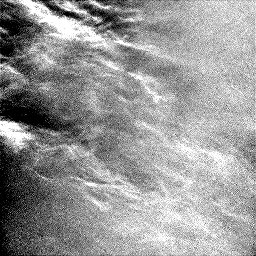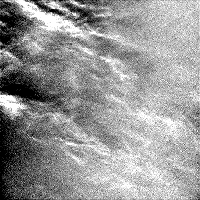
|
Clouds Sailing Overhead on Mars, Enhanced
- Click the image above for a larger view
 Movie Download Options
Movie Download Options- Full-Res JPEG (511 x 511) (91.1 kB)
- Full-Res TIFF (511 x 511) (261.6 kB)
Caption:

Click on the image for larger animation
Wispy clouds float across the Martian sky in this accelerated sequence of enhanced images from NASA's Curiosity Mars rover.
The rover's Navigation Camera (Navcam) took these eight images over a span of four minutes early in the morning of the mission's 1,758th Martian day, or sol (July 17, 2017), aiming nearly straight overhead. They have been processed by first making a "flat field' adjustment for known differences in sensitivity among pixels and correcting for camera artifacts due to light reflecting within the camera, and then generating an "average" of all the frames and subtracting that average from each frame. This subtraction results in emphasizing any changes due to movement or lighting. The clouds are also visible, though fainter, in a raw image sequence from these same observations. On the same Martian morning, Curiosity also observed clouds near the southern horizon .
The clouds resemble Earth's cirrus clouds, which are ice crystals at high altitudes. These Martian clouds are likely composed of crystals of water ice that condense onto dust grains in the cold Martian atmosphere. Cirrus wisps appear as ice crystals fall and evaporate in patterns known as "fall streaks" or "mare's tails." Such patterns have been seen before at high latitudes on Mars, for instance by the Phoenix Mars Lander in 2008, and seasonally nearer the equator, for instance by the Opportunity rover . However, Curiosity has not previously observed such clouds so clearly visible from the rover's study area about five degrees south of the equator.
The Hubble Space Telescope and spacecraft orbiting Mars have observed a band of clouds to appear near the Martian equator around the time of the Martian year when the planet is farthest from the Sun. With a more elliptical orbit than Earth's, Mars experiences more annual variation than Earth in its distance from the Sun. The most distant point in an orbit around the Sun is called the aphelion. The near-equatorial Martian cloud pattern observed at that time of year is called the "aphelion cloud belt." These new images from Curiosity were taken about two months before aphelion, but the morning clouds observed may be an early stage of the aphelion cloud belt.
Background Info:
NASA's Jet Propulsion Laboratory, a division of the California Institute of Technology, Pasadena, manages the Mars Science Laboratory Project for NASA's Science Mission Directorate, Washington. JPL designed and built the project's Curiosity rover and the rover's Navcam.
More information about Curiosity is online at http://www.nasa.gov/msl and http://mars.jpl.nasa.gov/msl/ .
Cataloging Keywords:
| Name | Value | Additional Values |
|---|---|---|
| Target | Mars | |
| System | ||
| Target Type | Planet | |
| Mission | Mars Science Laboratory (MSL) | Hubble Space Telescope (HST), Mars Exploration Rover (MER), Phoenix |
| Instrument Host | Curiosity Rover | Hubble Space Telescope, Opportunity (MER-B), Phoenix Lander |
| Host Type | Rover | Lander, Space Telescope |
| Instrument | Navigation Camera (Navcam) | |
| Detector | ||
| Extra Keywords | Atmosphere, Dust, Grayscale, Movie, Water | |
| Acquisition Date | ||
| Release Date | 2017-08-09 | |
| Date in Caption | 2017-07-17 | |
| Image Credit | NASA/JPL-Caltech/York University | |
| Source | photojournal.jpl.nasa.gov/catalog/PIA21841 | |
| Identifier | PIA21841 | |
